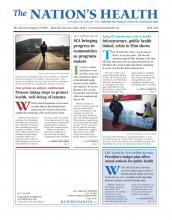As you get older, you may not move as fast as you used to, and with age comes a creaky joint or two. But if pain in your joints becomes a constant in your life and makes it harder to get around, it may be more serious than just being sore.
Persistent pain, aching, stiffness and swelling around the joints are all signs of arthritis. While your chance for having arthritis increases with age, arthritis affects people of all ages, says Chad Helmick, MD, senior medical epidemiologist at the Centers for Disease Control and Prevention's Arthritis Program. According to CDC, 52.5 million adults have arthritis and about 294,000 U.S. kids under 18 have arthritis or other rheumatic conditions.
Often there is no known cause for an arthritis diagnosis, while some types may be linked to a joint injury or factors such as being overweight or obese.
Osteoarthritis, which wears down the cartilage between your bones and weakens the whole joint, is the most common type of arthritis. But there are more than 100 non-inflammatory and inflammatory types, such as rheumatoid arthritis and gout. Women overall are more likely than men to have arthritis at all ages and gender may play a role in which type you have.
Women are more likely to have rheumatoid arthritis — an inflammation of the lining of your joints — and lupus, an autoimmune disease that can damage joints and other organs. Gout, which is a build-up of uric acid in the body and joints, is more common in men, Helmick says.
Twenty-three million adults who have arthritis find themselves limiting their activities because of it. And that pain can be even more difficult to manage because so many people with arthritis may also have to deal with other chronic conditions, such as diabetes and heart disease, CDC says.
“They can't walk as far, they can't stoop, bend and kneel as well, they have trouble climbing stairs, they have trouble grasping things that are in their hands,” Helmick says. “All of that can make participating in their valued life activities more difficult and limit their social life. It can get to the point of disability. It really reduces the quality of life. If you get to the point of organ failure, which we call joint failure, then you get a total (organ) joint replacement. That's a good thing to get if you need it, but it's unfortunate if you reach that point.”
Maintaining a healthy weight and staying physically active are ways you can prevent osteoarthritis, Helmick says. However, not all types of arthritis are preventable. That's why it's important to talk with your health care provider about safe and healthy ways to help manage arthritis and arthritis pain.
Moderate low-impact physical activities, such as biking, swimming and walking, are known to reduce arthritis pain, Helmick says. Talk with your health care provider about enrolling in arthritis self-management education programs that can teach you strategies for reducing joint discomfort. While your doctor may also prescribe medicine for the pain, there are other ways to tackle the discomfort, such as doing light stretches, icing the source of your pain and taking a warm shower, according to the National Institute of Arthritis and Musculoskeletal and Skin Diseases.

Photo by Nadofotos, courtesy iStockphoto.
“I would say 20 or 30 years ago doctors told people to rest their joints, and now they're saying the opposite because they realize everything around the joints, including the muscles, you've got to keep strong, too,” Helmick says. “Being physically active is a good thing to do. Some people worry being physically active will increase their pain or damage their joints more. They have to learn how to do it safely and get the payoff in reduced joint pain.”
Does my child have juvenile arthritis?
Arthritis doesn’t just happen in seniors. It can also affect children. Warning signs for parents who may think their kid has juvenile arthritis are limping from stiff joints, clumsiness and developing a high fever and skin rash, according to the National Institute of Arthritis and Musculoskeletal and Skin Diseases.
Parents of kids diagnosed with juvenile arthritis should assemble a health care team that includes specialists such as occupational therapists and rheumatology nurses to manage their child’s symptoms, the institute says. Parents should also keep communication open with kids and health care providers about pain management and encourage physical activity when appropriate, according to the institute.
For more tips on managing arthritis, visit www.cdc.gov/arthritis
- Copyright The Nation’s Health, American Public Health Association









